Signals
An example of signalling when turning right taken from our learner's video series
You rarely know the identity of the other people who you share the road with. Despite this fact, you trust your safety to these strangers every time you venture out in your car.
When you are a pedestrian, you are even more vulnerable to the potential actions of strangers in vehicles.
Generally is not usual to talk to random strangers who pass us in the street; we make a point of warning our children about the dangers of such behaviour. But when driving, talking to strangers is essential; we do this by using signals.
Given that we know nothing about those who we are communicating with, it's especially important that our signalling 'language' is clear and unambiguous to ensure that the message they receive is the one that we intend. You can help to ensure clarity by using the universally recognised signals illustrated in the Highway Code!).
There are eight legitimate ways for you to 'talk' to other road users. These are:
- Direction indicators
- Arm signals
- Brake light
- Horn
- Hazard lights
- Flashing headlights
- Fog lamps
- Reversing lamps
- (Car) Body language or positioning
How do I know when to give a signal?
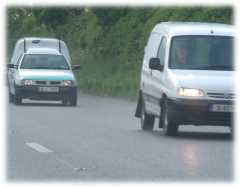 The Highway Code states that you should give signals if they will help or warn other road users.
The Highway Code states that you should give signals if they will help or warn other road users.
You have to ask yourself the question: "Will anyone benefit from my signal?"
In the situation illustrated on the right it looks as though the second van might be moving out to overtake.
While a signal might not affect drivers who are behind the second van (because they can probably see the van driver's intentions by his road position), the driver of the approaching car (from which the photo was taken) might benefit from a signal in order to keep out of the way. The driver of the van that is about to be overtaken might also be alerted by a signal (indicator or headlamp flash).
This photo also illustrates the power of 'body language'. By taking up an early position the second van can indicate his intention to move out and overtake - however, it must be stressed that road position is not a substitute for a well timed, clear signal.
Note: A good driver will be aware of the 'signal' that his road position is giving at all times. Could your road position confuse other drivers (for example, swinging out before a left turn). Always consider the signal that your road position might be giving to others.
Signal or not?
A typical Part-Two test example...
If you are pulling up to stop on a deserted road a signal is of no practical use simply because there will be no-one to see it.
Alternatively, if you are intending to turn at a junction from a deserted road into another road, but you cannot see into the new road, then it might be wise to signal, just in case there is some one around the corner who will benefit.
Road to confusion
 An area of confusion and mixed advice from instructors and trainers is whether or not a signal should be given when you are in a 'left-turn only' or 'right-turn only' lane.
An area of confusion and mixed advice from instructors and trainers is whether or not a signal should be given when you are in a 'left-turn only' or 'right-turn only' lane.
There are two simple points here:
-
Not all drivers will realise that there is a dedicated turn lane. This could be because other vehicles are obscuring signs or markings.
-
Pedestrians may not be aware of the rules that apply to drivers.
Based on the information above, the answer about whether or not to signal in any situation is simple, if the signal is not misleading, and there is someone who might reasonably benefit, give it!
The examples above now expand the question that you ask yourself before signalling question and it becomes something like:
"Will anyone benefit from the signal, or is there anyone that I cannot yet see who might benefit from a signal".
If we consider the junction example from the box above.
The argument could be made at the junction that if you are alert and following the 'information in, information out' mode of thinking, you could signal as soon as another vehicle appears.
The problem at places where there is restricted vision, such as some junctions the drivers of other vehicles may be able to see the front of your vehicle before you see them – by signalling in these situations you give an early warning.
This does not mean that you always need to signal at junctions. If there is an open view and you can be 100% sure that no one will benefit, a signal would be pointless. But if there is a reasonable assumption that there might be someone to benefit, give a signal.
The next important point to remember about signals is that they must not be misleading.
Are you making your intentions clear?
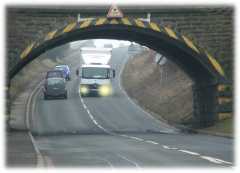 Flashing your headlights that say 'thank you' to one driver may be read as an invitation to pull out and cross in front of you by another.
Flashing your headlights that say 'thank you' to one driver may be read as an invitation to pull out and cross in front of you by another.
Signalling to turn into a gateway beyond a junction may mislead others who may think that you intend to turn into the junction.
Is the truck in the photo on the right inviting you to carry on or warning you that he is coming through?
If you have considered all of the factors about who may or may not be affected by your signal, and you are still in doubt about whether to signal or not, it will usually be the best policy to give a signal.
If in doubt - give a signal
If a situation arises during Part-Two where you are unsure what to do,, explain your thinking to the examiner – if you are wrong you will still be marked down, however, by making your reasoning clear the examiner will understand your approach and be able to offer constructive feedback at the end of the test.
Example
"There is no one directly ahead or behind, however, I'm signalling because there is a driver sitting in the van in the driveway on the right".
In this example it's possible that the examiner might not have seen the van driver (because of reflections on the windscreen, etc.). Your explanation could earn 'brownie points'.
Alternatively, the examiner might notice that the driver is eating his lunch while someone else is busy unloading the van - if this was the case you would be missing useful information that suggested a signal was not required.
Acting on the signals of others
Other people are not always clear about the way they signal. You must respect, and act on, all signals given by others. However, exercise caution, especially where flashing headlights are concerned.
If you are clear that someone is flashing to give way to you, make sure that there is no one else around who thinks that the signal is for them! Also check that it is safe to proceed, never rely on someone else's judgement.
If we consider the example of the truck in the picture above – he is actually signalling to warn you that he is coming through in the centre of the road. The truck needs to position in the centre because of the bridge arch; it is also travelling downhill and so might have difficulty slowing and stopping.
If you automatically read the trucks flashing headlights as a "I am giving way to you" you will be in big trouble!
Using flashing headlights
Like the horn, flashing headlights warn other road users of your presence. They should not be used for any other reason.
Although you know who you are flashing at and what you mean, others might not.
You could for example, be flashing to give way to a driver on the right. While you are watching him and he is saying 'thank you', a driver on the left (who thought the signal was for him) could pull into your path. Crash!
Click here for detailed information about the dangers of flashing headlights.
Signal timing
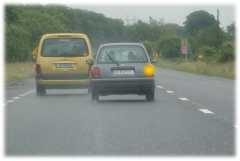 Signals by indicator and/or arm are used to give advance information to others about your intended direction or road position changes.
Signals by indicator and/or arm are used to give advance information to others about your intended direction or road position changes.
This may seem to be re-stating the obvious information covered so far, but many people forget that signals are advance warnings.
The photo on the right caught the first flash of the driver's indication to overtake...
A signal given this late is of little use to anyone. the only thing it tells us is that we should be aware that the driver might be on 'auto pilot' and not paying sufficient attention to the traffic situation.
The correct timing of signals is essential if they are going to be of use to other road users.
Getting the timing right is relatively simple, make sure that your indicators flash at least four times before starting the next part of your manoeuvre, i.e., before you start to brake, accelerate or make a position change. Note that some vehicles have a 'three flash' mode for overtaking, etc. Sometimes three flashes is enough - but sometimes it takes quite a few more before drivers behind wake up... Take each situation as you fins it.
Observation task
The next time that you make a motorway journey, watch the drivers of other vehicles and ask yourself whether their signals are correctly timed before they change lanes.
Do you realise that they are going to manoeuvre before, or after they give their signal?
If you realise before the signal comes on, they are obviously signalling too late.
You will often notice a slight deflection (wobble!) of the steering when the (late) mirror check is made, then the car will start to move towards the white line and finally, the signal will come on as the car starts to cross the line.
So far, we have been thinking mainly about direction signals and flashing headlights, however, the same considerations must be made when any signal is used.
Signalling or just waving?
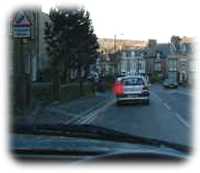 Arm signals are useful to 'get you home' in the event of signal or brake light failure (as in the picture on the right), but it should be noted that they are not acceptable as the only means of signalling on advanced or other driving tests.
Arm signals are useful to 'get you home' in the event of signal or brake light failure (as in the picture on the right), but it should be noted that they are not acceptable as the only means of signalling on advanced or other driving tests.
It is illegal to drive with defective signals or other lights. Make sure that you make your regular checks and carry spare bulbs!
Apart from being useful in the event of bulb failure, drivers need to be able to recognise arm signals given by cyclists, motor cyclists and horse riders.
Arm signals are not a specific requirement during most advanced tests, however, if an arm signal would be useful to reinforce an indicator or brake light, you will be well advised to give one.
The boxes below consider some common situations where arm signals can be useful.
Turning right
 If you signal to turn right just as you approach a parked vehicle, other drivers, or pedestrians might think that you are simply indicating to pass the parked vehicle. Because of this they might not realise that you will be slowing down.
If you signal to turn right just as you approach a parked vehicle, other drivers, or pedestrians might think that you are simply indicating to pass the parked vehicle. Because of this they might not realise that you will be slowing down.
A right-turn arm signal in addition to your signal can reinforce your intention to turn.
Approaching a Zebra Crossing
Because the Zebra Crossing is uncontrolled there is no way for oncoming drivers to  know that you intend to stop for a pedestrian (unlike controlled crossings which have a red light or traffic attendant).
know that you intend to stop for a pedestrian (unlike controlled crossings which have a red light or traffic attendant).
By giving a clear slowing down arm signal you inform approaching drivers of your intention to stop and reinforce the brake lights for drivers behind who might be half asleep (many drivers!).
Pulling up near junctions
 When intending to stop just before or after a junction an arm signal can reinforce or replace an indicator signal.
When intending to stop just before or after a junction an arm signal can reinforce or replace an indicator signal.
For example if you intend to reverse around a corner into a junction on the left, a left turn signal might cause a driver who is waiting at the junction on the left, to pull out.
A left turn arm signal would be visible to drivers behind you but not as apparent to the waiting driver.
Brake lights
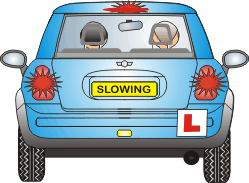 Sometimes it can be useful to touch the brake pedal very lightly, without slowing down, to activate the brake lights. By doing you this will give drivers who are following too closely a bit more time to react when you start to slow down.
Sometimes it can be useful to touch the brake pedal very lightly, without slowing down, to activate the brake lights. By doing you this will give drivers who are following too closely a bit more time to react when you start to slow down.
However, do not confuse this with the dangerous use of brake lights to signal someone to 'back off'. If you don't like the driver behind, let him pass - that way you'll get to see the accident without being involved in it!
Remembering that your brake lights are a signal, you must always check your mirrors before using them. "How will braking affect following drivers?", "Is it safe to brake?", "Do I need to use my brake light signal early to warn the driver behind?" Etc.
Horn
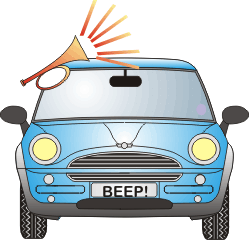 The horn is a warning instrument and as such it must be used early enough to be of use.
The horn is a warning instrument and as such it must be used early enough to be of use.
There is not much point sounding the horn in anger at someone who has just pulled out in front of you. It might make you feel better but you could upset the other driver.
Drivers who are upset are dangerous. They might simply drive nervously paying too much attention to the mirror rather than the road ahead – alternatively they could stop you and take out a big knife in reply to your 'unsociable behaviour'.
Look well ahead and if someone looks as though they might be about to pull out, use the horn to draw their attention to your presence. It can often be a good idea to acknowledge with a friendly wave when the driver looks at you.
The horn is NOT an alternative to the brake pedal. You must always slow down if there is danger present.
Hazard lights
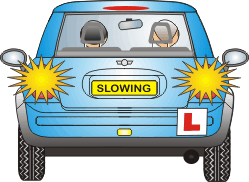 These can be used to emphasise that your vehicle is parked. Make sure that the lights are clearly visible to the front and rear on both sides, otherwise people who see only one light might mistake it for a direction indicator.
These can be used to emphasise that your vehicle is parked. Make sure that the lights are clearly visible to the front and rear on both sides, otherwise people who see only one light might mistake it for a direction indicator.
Hazard lights are not an excuse for poor parking!
It is acceptable, and desirable, to use hazard warning lights on the move at times of danger when rapid deceleration is required, e.g.,, approaching a motorway hold-up.
Fog lights
Fog lights are not normally considered as a signal, but perhaps they should be! (At least in the case of rear fog lights.)
Like the horn and flashing headlights, fog lights are used to warn others of your presence and should only be used for as long as 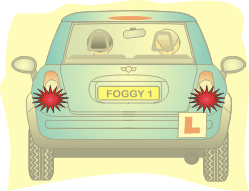 necessary in order to fulfil that task.
necessary in order to fulfil that task.
In other words, as soon as a following driver is close enough to see you, your rear fog lamps should be switched off.
Front fog lights should only be used when driving in dense fog and are usually only necessary at night (with headlights switched off). The beams pattern of these lights is flat and low to reduce the amount of light reflected back to the driver while still making the car visible to others.
Using front fog lamps in conjunction with dipped headlights at night rather defeats the object; the light from the headlights will be reflected back and this reduce the driver's ability to see.
In daytime fog using front fog lights and headlights together might help to make your car more visible to other road users.
Get more advice about driving in fog here.
Reversing lights
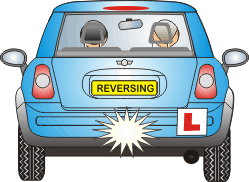 To a degree, your reversing lights will give you some view behind when reversing in the dark, however (ensuring that you do not confuse or dazzle anyone) in most cars you can get more light to help your rear vision by using your brake lights and/or rear fog lights.
To a degree, your reversing lights will give you some view behind when reversing in the dark, however (ensuring that you do not confuse or dazzle anyone) in most cars you can get more light to help your rear vision by using your brake lights and/or rear fog lights.
the primary purpose of reversing lights is to signal to other road users that you are reversing or about to reverse. With this in mind all the rules for good signalling apply: "How will others read my signal?", "Is my signal confusing?" Etc.
Have you ever found yourself behind a car with a reversing light on where the driver isn't even looking behind, he/she has selected reverse without considering the signal and is busy paying attention to something else before starting to reverse; in the meantime, drivers behind are not quite sure what is happening.
Next: In Step 5 we consider the manoeuvre itself.